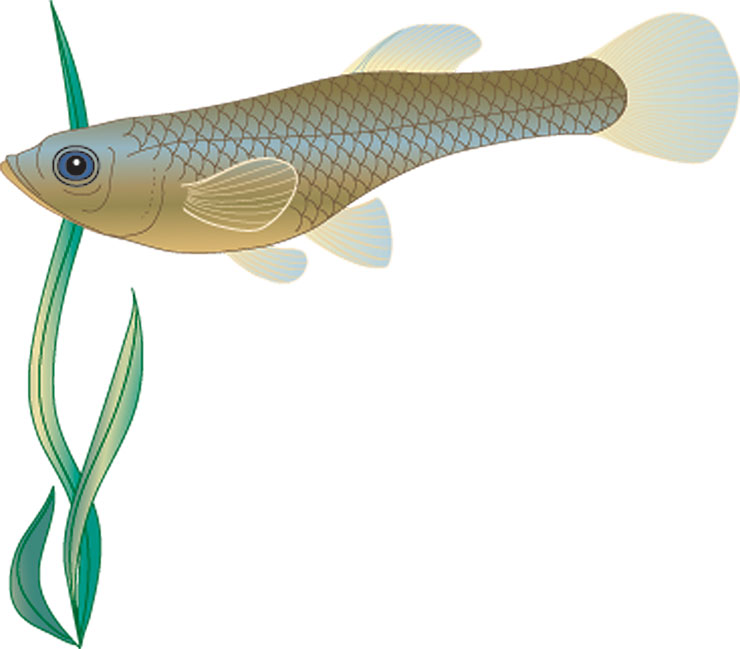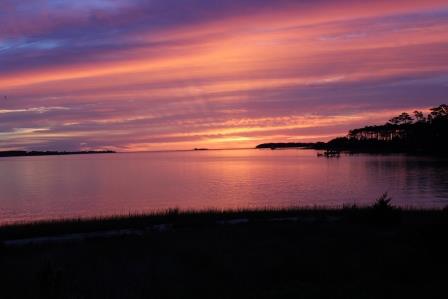NATURALIST’S NOTEBOOK: Molly by the Sea

I wake up before the sun does to the sound of gulls barking for fish. They’re hungry and I am too. I can hear Grandpa making breakfast in the kitchen.
“Get up, Little Fish,” he yells from the top of the stairs. Little Fish is Grandpa’s nickname for me.
I jump out of bed and pull on my overalls, being careful not to stub my toe in the grey dawn light. I hurriedly brush my teeth and wash my face. I do not take time to braid my hair the way I usually do, because today is the day I’ve been waiting for. Instead, I let it hang down my back like mermaid’s hair.
Grandpa asks me how many pancakes I want. I ask for two. He has made my favorite thing for breakfast since this is my special day. The day Grandpa promised to take me out on his boat. Grandpa lives in a little house on Ocean Isle Beach. That’s an island off the coast of North Carolina. I love to visit Grandpa’s island house.
Grandpa laughs at me as I eat my breakfast quickly. “Slow down, Molly, there is plenty of time. You eat like a MOSQUITOFISH.”
“What’s a mosquitofish?” I ask.
Grandpa pulls down a book from his shelf and shows me a colorful picture of a tiny silver fish with a wide tail. “A mosquitofish eats mosquito larvae. It swims into shallow, grassy areas where bigger fish cannot go and when it finds food, it eats and eats and eats.”
I wash my dishes in the sink and run to put on my rain boots and jacket that have been waiting for me by the front door. I look out the window at the canal where all the boats are still sleeping in their slips.
“Now?” I ask.
“Now,” he says with a smile.
I run out of the door, down the steps and onto the dock where Grandpa’s little boat is just waking up. His boat’s name is The Star of the Sea. That’s what my name, Molly, means. It’s a beautiful boat, with sleek white sides that shimmer like the water does.
Grandpa comes down onto the dock and gets the boat ready for our ride. I get as close as I can to the water without falling in and watch the little waves along the surface ripple in the bright morning light.
“Do you see them, Little Fish?”
“See what?” I ask.
“The tiny plants and animals in the water?”
“There are tiny things in the water?” I look again, but all I see is the sand and dirt at the bottom. “Where are they? I don’t see them.”
Grandpa walks over and stares down into the water with me.
“You need a microscope to see them. It takes tiny things that we can’t see and makes them appear bigger.”
“What are they called?” I ask.
“The little animals are called ZOOPLANKTON and the small plants are called PHYTOPLANKTON. There are billions of them in the ocean, the sound and even freshwater. They have different shapes and sizes and colors. Phytoplankton make oxygen, the stuff we breathe,” he explains. “They cannot swim very well but drift along, moved by the currents. You are definitely a better swimmer.”
I practice swimming, squiggling my arms and squirming my body as I run around the dock. Pretty soon, Grandpa says it’s time to untie the boat. He loosens the knot that keeps The Star of the Sea tied to the dock and throws the rope into the boat. He puts on my life jacket and then puts his on too. He lifts me up next to him and carefully backs the boat out into the canal.
“Here we go!” The wind starts to gently toss my hair as we glide through the water towards the sea. The air smells fresh and clean, and the sun begins to warm my back as it gets higher and higher in the sky. Before I know it, we’re zipping along the Atlantic Ocean.
I look to my left and all I see is ocean. I look to my right and all I see is the shore with houses and umbrellas and lots of people lying out in the sun. Suddenly, I see a big brown and white bird fly straight at the water. Its feet disappear for a second under the churning waves. When it begins to fly again, I see it carrying something between its toes.
“Grandpa!” I shout. “Did you see that?” “It’s an OSPREY. See its beautiful feathers? People also call them sea hawks because they catch fish with their feet. They fly high in the air looking for fish swimming in the water.
Their toes are made specially for holding onto slippery fish.”
I watch as the sea hawk begins to disappear in the distance. I go to the front of the boat and spread my arms out, waving them up and down until I look like I’m flying too.
Grandpa brings the boat closer to shore and stops right near a sand bar.
“Look, Little Fish, do you see it?”
“See what?” I ask.

“The STINGRAY! Look, over there, near the sand bar!”
I look in the water where Grandpa is pointing. I see a shadow move along the bottom. It’s gray and wiggly. Then the shadow gets bigger and starts to come to the surface. I can see its small black eyes on the top of its head. A long thin tail trails behind it.
“Stingrays have no bones in their body.” Grandpa says. “They only have cartilage, like what’s in your nose.”
“What’s that on its tail?” I ask.
“It’s a large stinger called a barb. See how the barb is about a third of the way down its tail? The stingray has to arch its tail to defend itself.”
“That is very smart of them,” I say.
Grandpa starts the boat again. “We’d better get away from the sand bar. We don’t want the boat to get stuck.”
Grandpa takes the boat to nearshore waters and shows me the great long pier that sticks far out into the water.
We see people walking along the top of it and I wave hello to them as we zoom past.
Grandpa asks if I would like to walk along the pier too. I say that I would.
Grandpa takes us back to the canal and puts the boat to rest near the dock. He takes my hand and we walk down the long shore street until we reach a stairway down to the water. I run down onto the sand. I take my boots off and wriggle my toes around until they have disappeared. My toe feels something buried underneath it, so I reach down with my hand and feel around. I pull and pull until the mysterious thing comes up. It’s long and brown and has lots of leaves on it.
“Grandpa, what is this?” I ask and hold it up.
“That’s SARGASSUM. It’s a type of brown algae that lives in the ocean. Sometimes it washes ashore and gets buried in the sand. Do you see the balloons on it?”
“Balloons?” I ask.
“Yes, it has air bladders that look like tiny balloons. It helps the sargassum float and keeps it from sinking to the bottom of the ocean.”
I put the sargassum back in the water and watch the waves carry it down the shore. Grandpa and I walk down to the pier and go all the way to the very end. We watch the fishermen cast their lines into the ocean. I see a gull take a piece of bread off of the railing and fly quickly away to eat his snack. Grandpa takes me under the pier so that I can play and splash the water as it rolls in along the shore. I happen to look at the water as one of the waves goes back out to sea. There, stuck in the sand, is something flat and round. I reach down and pick it up.
“Grandpa, what is this?” I say.
“You’ve found a KEYHOLE URCHIN, Molly. Sometimes people call them sand dollars, but that’s not their correct name. They live in the sand and on the ocean floor. See the pretty flower design on its top?” I trace the five little petal shapes with my finger. “They have another silly name. Guess what it is?”
“What?” I say.
“They’re called sea cookies because they’re round and flat.”
“That is a very silly name,” I say.
Grandpa smiles. “Speaking of cookies, how about you and I go back and have some of our own? And maybe some ham sandwiches. It’s time for lunch.”
My tummy begins to growl. I think that is a very good way to end my morning at the seashore.
For teacher and student resources, visit: ncseagrant.org/s/molly.
This article was published in the Spring 2012 issue of Coastwatch.
For contact information and reprint requests, visit ncseagrant.ncsu.edu/coastwatch/contact/.
- Categories:


